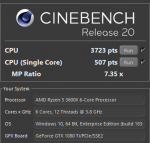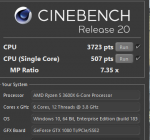Michael Nager
New member

In the months that have passed since I started experimenting with the Ryzen 5 3600X on my X470 motherboard (GigaByte X470 AURUS Gaming 7 WiFi Rev. 1.1 and then helping my friend configure his Ryzen 3900X on his motherboard (ASUS X570 ROG Crosshair VIII Hero (WiFi).
I bought the X570 motherboard I wanted (at a price I was willing to pay) the GigaByte X570 AURUS XTREME and experimented with my 3600X in that until I managed to get the CPU I wanted, the Ryzen 9 3950X which I now have.
A YouTube Techie who I respect from a channel called "Actually Hardcore Overclocking" https://www.youtube.com/channel/UCrwObTfqv8u1KO7Fgk-FXHQ called "Buildzoid" who recently made three videos on the topic of configuring PBO on a the same GigaByte board I have, an ASUS board and then general thoughts on PBO:
1) The easy way to get a bit more performance out of Ryzen 3000 CPUs on Gigabyte X570 motherboards
2) The easy way to get a bit more performance out of Ryzen 3000 CPUs on Gigabyte X570 motherboards
3) The easy way to get a bit more performance out of Ryzen 3000 CPUs on Gigabyte X570 motherboards
In the course of his experimentation he has managed to degrade his Ryzen 7 3700X and I fear that with the way he is configuring his Ryzen 9 3950X he will be doing the same thing there as well.
In the video he has put up some benchmarks where, by configuring PBO in the BIOS he managed to get the results up by some amount, the problem is though, that he is doing so at higher voltages than I consider to be prudent and also at higher temps than I experience with my 3950X.
His maximum CineBench R20 result after configuring his 3950X was at 9,554.
The way I configure my Ryzen 9 3950X I get a CineBench R20 score of 10,170 and still remain within the specification as laid down by TSMC for their 7nm Node. This specifies a far lower voltage than AMD considers safe and personally I am going to go with the recommendations of the creator of the 7nm Node and constrain the voltage of my Ryzen 3000 CPUs to 1.3 Volts MAXIMUM
Because of my back problems (I have had two spine operations and have spinal arthritis) I have to keep the room temperature pretty warm.
The ambient temperature in my room is 28 - 29 °C and you should keep that in mind when I show you the following benchmark results of my system:
My R9 3950X with SMT On:
1) CineBench R20 all-core score of 10,170 and a single core score of 500
2) FireStrike EVGA 1080 Ti SC2 I have a Graphics Score of 28,213, a Physics Score of 33,848 and a Combined Score of 15,488
3) FireStrike Extreme EVGA 1080 Ti SC2 I have a Graphics Score of 14,130, a Physics Score of 33,821 and a Combined Score of 7,057
4) FireStrike Ultra EVGA 1080 Ti SC2 I have a Graphics Score of 7,180, a Physics Score of 34,089 and a Combined Score of 3,902
5) TimeSpy EVGA 1080 Ti SC2 I have a Graphics Score of 10,292 and a CPU Score of 15,390
6) TimeSpy Extreme EVGA 1080 Ti SC2 I have a Graphics Score of 4,791 and a CPU Score of 9,421
7) Ghost Recon Wildlands benchmark 1080p everything at max FPS 86.33, CPU 14.7% (Min. 9.8% Max. 23.2%) and GPU 96.7%
8) 7zip Compression Average 124.906 MB/s, Decompression 199.303 MB/s
My R9 3950X with SMT Off:
1) CineBench R20 all-core score of 7,817 and a single core score of 513
2) FireStrike EVGA 1080 Ti SC2 I have a Graphics Score of 28,295, a Physics Score of 30,052 and a Combined Score of 15,833
3) FireStrike Extreme EVGA 1080 Ti SC2 I have a Graphics Score of 14,170, a Physics Score of 30,168 and a Combined Score of 7,076
4) FireStrike Ultra EVGA 1080 Ti SC2 I have a Graphics Score of 7,186, a Physics Score of 30,164 and a Combined Score of 3,906
5) TimeSpy EVGA 1080 Ti SC2 I have a Graphics Score of 10,271 and a CPU Score of 15,340
6) TimeSpy Extreme EVGA 1080 Ti SC2 I have a Graphics Score of 4,788 and a CPU Score of 7,564
7) Ghost Recon Wildlands benchmark 1080p everything at max FPS 86.51, CPU 23.4% (Min. 17.2% Max. 48.6%) and GPU 97%
8) 7zip Compression Average 103.106 MB/s Decompression 129.844 MB/s
The cooler I am using is the AlphaCool EisBaer 360 LT which as the name suggests has a 360 rad and I am running it with three Noctua NF-A12x25 fans.
I bought the X570 motherboard I wanted (at a price I was willing to pay) the GigaByte X570 AURUS XTREME and experimented with my 3600X in that until I managed to get the CPU I wanted, the Ryzen 9 3950X which I now have.
A YouTube Techie who I respect from a channel called "Actually Hardcore Overclocking" https://www.youtube.com/channel/UCrwObTfqv8u1KO7Fgk-FXHQ called "Buildzoid" who recently made three videos on the topic of configuring PBO on a the same GigaByte board I have, an ASUS board and then general thoughts on PBO:
1) The easy way to get a bit more performance out of Ryzen 3000 CPUs on Gigabyte X570 motherboards
2) The easy way to get a bit more performance out of Ryzen 3000 CPUs on Gigabyte X570 motherboards
3) The easy way to get a bit more performance out of Ryzen 3000 CPUs on Gigabyte X570 motherboards
In the course of his experimentation he has managed to degrade his Ryzen 7 3700X and I fear that with the way he is configuring his Ryzen 9 3950X he will be doing the same thing there as well.
In the video he has put up some benchmarks where, by configuring PBO in the BIOS he managed to get the results up by some amount, the problem is though, that he is doing so at higher voltages than I consider to be prudent and also at higher temps than I experience with my 3950X.
His maximum CineBench R20 result after configuring his 3950X was at 9,554.
The way I configure my Ryzen 9 3950X I get a CineBench R20 score of 10,170 and still remain within the specification as laid down by TSMC for their 7nm Node. This specifies a far lower voltage than AMD considers safe and personally I am going to go with the recommendations of the creator of the 7nm Node and constrain the voltage of my Ryzen 3000 CPUs to 1.3 Volts MAXIMUM
Because of my back problems (I have had two spine operations and have spinal arthritis) I have to keep the room temperature pretty warm.
The ambient temperature in my room is 28 - 29 °C and you should keep that in mind when I show you the following benchmark results of my system:
My R9 3950X with SMT On:
1) CineBench R20 all-core score of 10,170 and a single core score of 500
2) FireStrike EVGA 1080 Ti SC2 I have a Graphics Score of 28,213, a Physics Score of 33,848 and a Combined Score of 15,488
3) FireStrike Extreme EVGA 1080 Ti SC2 I have a Graphics Score of 14,130, a Physics Score of 33,821 and a Combined Score of 7,057
4) FireStrike Ultra EVGA 1080 Ti SC2 I have a Graphics Score of 7,180, a Physics Score of 34,089 and a Combined Score of 3,902
5) TimeSpy EVGA 1080 Ti SC2 I have a Graphics Score of 10,292 and a CPU Score of 15,390
6) TimeSpy Extreme EVGA 1080 Ti SC2 I have a Graphics Score of 4,791 and a CPU Score of 9,421
7) Ghost Recon Wildlands benchmark 1080p everything at max FPS 86.33, CPU 14.7% (Min. 9.8% Max. 23.2%) and GPU 96.7%
8) 7zip Compression Average 124.906 MB/s, Decompression 199.303 MB/s
My R9 3950X with SMT Off:
1) CineBench R20 all-core score of 7,817 and a single core score of 513
2) FireStrike EVGA 1080 Ti SC2 I have a Graphics Score of 28,295, a Physics Score of 30,052 and a Combined Score of 15,833
3) FireStrike Extreme EVGA 1080 Ti SC2 I have a Graphics Score of 14,170, a Physics Score of 30,168 and a Combined Score of 7,076
4) FireStrike Ultra EVGA 1080 Ti SC2 I have a Graphics Score of 7,186, a Physics Score of 30,164 and a Combined Score of 3,906
5) TimeSpy EVGA 1080 Ti SC2 I have a Graphics Score of 10,271 and a CPU Score of 15,340
6) TimeSpy Extreme EVGA 1080 Ti SC2 I have a Graphics Score of 4,788 and a CPU Score of 7,564
7) Ghost Recon Wildlands benchmark 1080p everything at max FPS 86.51, CPU 23.4% (Min. 17.2% Max. 48.6%) and GPU 97%
8) 7zip Compression Average 103.106 MB/s Decompression 129.844 MB/s
The cooler I am using is the AlphaCool EisBaer 360 LT which as the name suggests has a 360 rad and I am running it with three Noctua NF-A12x25 fans.





